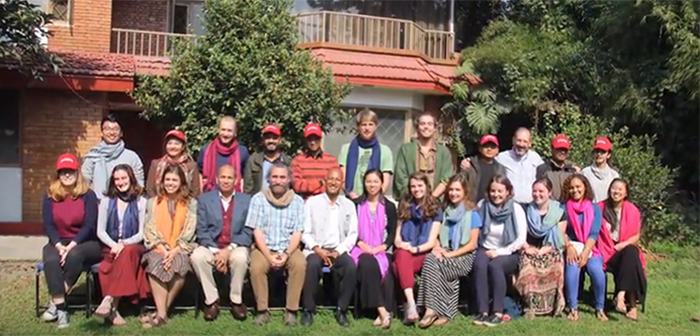Dickinson College Students Research Climate Change in Nepal

Students in the Nepal Mosaic partnered with local graduate students to conduct ethnographic fieldwork in Nepal.
Mosaic combines classroom study with fieldwork in communities vulnerable to climate change
by MaryAlice Bitts-Jackson
It’s a long road from downtown Carlisle to the rural villages in Nepal—some 7,477 miles, as the crow flies, and far outside of the comfort zones of the dozen Dickinson students who traveled there to study the implications of climate change. By the end of their trip, the students not only had a deeper understanding of that complex issue but also had on-the-ground experience in conducting cross-cultural research.
The students were enrolled in a Mosaic, an intensive semesterlong course, only available at Dickinson, that takes students into local and global communities to study contemporary issues from multiple perspectives. In the past, Dickinson Mosaics have explored:
- civil rights in South Africa and Mississippi
- human response to disaster
- migration in the Mediterranean
- race and education in the U.S. and South Africa
- global climate change
- religion and culture in Morocco
- natural habitats and their coexistence with humankind
- Cuban culture and life and much more.
Students in the Nepal Mosaic, held in fall 2017, wanted to examine how climate change affects people around the world. They learned about resilience—the ability to respond and adapt to sudden shocks and long-term stresses—and how vulnerable communities work to enhance and build more resilient systems in the face of water insecurity, modifications to agricultural systems, changing migration patterns and other social, economic and political challenges. Nepal offered a perfect case study.
A unique example
The people of Nepal are highly dependent on the environment and natural resources for their livelihoods, and because of Nepal’s unique topography, the country is strongly affected by climate change. Projections suggest that changes in agricultural and water availability, along with intensifying natural disasters, will magnify already existing challenges and put people at increased risk. On top of that, Nepal has endured political and economic challenges over the last several decades, including a decade of civil war and a 2015 catastrophic earthquake. Ironically, as an agriculturally based society with little industrial capacity, the country contributes very little to rising global levels of carbon dioxide.
To gain a deeper understanding of human security and climate change in Nepal, students spent the first half of the semester learning background information—about the dimensions of human security, science of global climate change, Nepali history and culture and the concept of collaboration as a vehicle for value—in courses taught by Michael Beevers, associate professor of environmental studies; Michael Fratantuono, associate professor of international studies and international business & management; and Neil Leary, director of the Center for Sustainability Education.
The Mosaic students also learned how to conduct ethnographic fieldwork—everything from developing research questions and designing a study and questionnaire to interviewing people and compiling, interpreting and presenting results. Then it was time to take a three-week research trip to Nepal, where they put what they were learning into action.
On-the-ground research
The trip began with a climate-change conference led by Nepali experts and attended by the acting U.S. ambassador to Nepal. The students were divided into four research groups. Each group collaborated with graduate students from the local Institute of Crisis Management Studies and went out into small villages in the Kavrepalanchok area of Nepal to conduct interviews the students and their research partners had designed.
They asked dozens of community and NGO leaders, schoolteachers, youth leaders, farmers, women’s groups and others whether they were aware of changing weather patterns, how they were affected, what they were doing to adapt and what they were doing to build community resilience. Respondents overwhelmingly identified water availability as a key issue. The students shared preliminary findings with representatives from all four villages.
Mosaic participants also organized a traditional Nepali dinner with Dickinson alumni as well as parents and high schoolers who’d expressed interest in attending Dickinson. On their return, they compiled and analyzed their findings and put together a comprehensive research paper, sharing their findings with the campus community last April.
Far-reaching effects
The Mosaic students indicated that while they’d learned a great deal about human security and climate change in Nepal, they also learned about the need to develop cross-cultural communication skills to solve complex global problems. Further, they reflected on their own carbon usage.
The effects can be far-reaching, notes Nam Nguyen ’18, who has already taken those lessons into new contexts as a data professional who analyzes climate-resilience portfolios of the International Fund for Agricultural Development and the World Food Program. “Without this Mosaic, my environmental studies and international development focus would not have had such a strong direction,” he says. “I would not have had this wonderful chance without this experience.”
TAKE THE NEXT STEPS
Published March 19, 2019